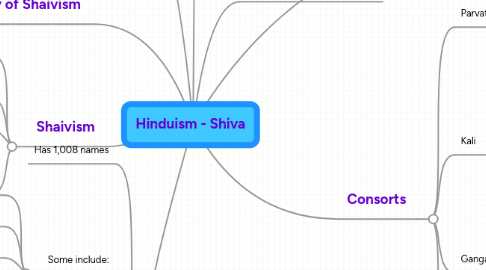
1. History of Shaivism
1.1. Originated in India
1.2. Spread Shaivism to south India by great sage, Agastya
2. Names
2.1. Has 1,008 names
2.2. Some include:
2.2.1. Mahadeva (the great god)
2.2.2. Mahesh
2.2.3. Rudra
2.2.4. Neelkantha (the blue-throated one)
2.2.5. Ishwar (the supreme god)
2.2.6. Mahayogi (great ascetic)
2.3. Mantras
2.3.1. Sadyojāta
2.3.2. Vāmadeva
2.3.3. Aghora
2.3.4. Tatpuruṣa
2.3.5. Īsāna
2.3.6. (5 is a sacred number for Shiva)
3. Shaivism
3.1. Revers Shiva as supreme being
3.2. Widespread through India, Sri Lanka, and Nepal
3.3. Believes that Shiva is All and in all
3.4. Kashmir Shaivism
3.4.1. Considered to be the mot pure spiritual path
3.4.2. Striking similarities between Jesus' teachings & teachings of Kashmir Shaivism
4. Worship
4.1. Mananam
4.1.1. Uttering Shiva mantras or prayers
4.1.2. Listening to others about Shiva
4.1.3. Meditating upon significance of Shiva
4.2. Sravanam
4.2.1. Also listening about Shaivism
4.3. Kirtanam
4.3.1. Singing praises of Shiva
4.3.2. When done in groups, called bhajan
5. Overview
5.1. 3rd deity of the Hindu triad
5.2. God of destruction
5.2.1. Also destruction of evil
5.3. Associated with creation
6. Attributes
6.1. Often shown with a white bull
6.2. Depicted as many different things
6.2.1. Represented as a phallus
6.2.2. Sometiems appears naked with demons
6.2.3. Often depicted carrying a trident
6.3. Seen as half male, half female
7. Consorts
7.1. Parvati
7.1.1. Said to have both mild and terrible aspects
7.1.1.1. (Like Shiva)
7.1.2. Married women love her for her happy marriage
7.1.3. When shown with Shiva, has 2 hands
7.1.4. Alone, has 4 hands
7.2. Kali
7.2.1. Associated with death & destruction
7.2.1.1. (Also like Shiva)
7.2.2. Now considered goddess of time & change
7.2.3. Darker aspect of Durga
7.3. Ganga
7.3.1. Incarnation of the sacred river, the Ganges
7.3.2. Sister of Parvati
7.3.3. Usually represented as a beautiful women with a fish tail, riding on a sea monster
7.4. Durga
7.4.1. Considered fiercer form of Parvati
7.4.2. Exists in a state of fierce compassion
7.4.3. Slays demons
7.4.4. In Sanskrit, her name means "invincible"
